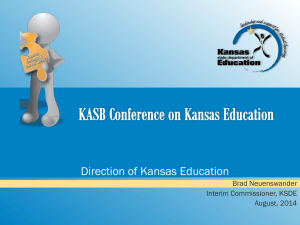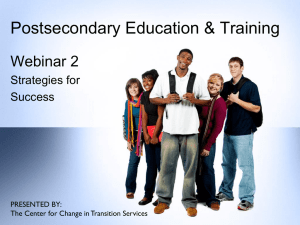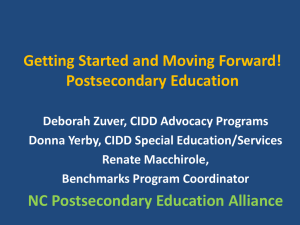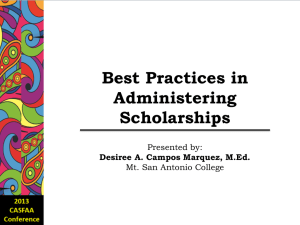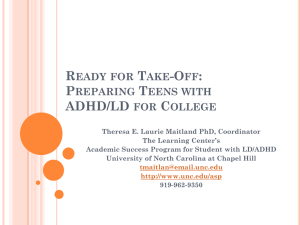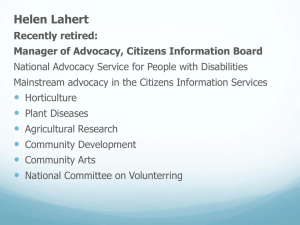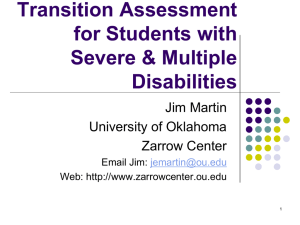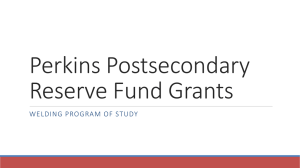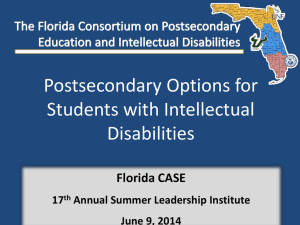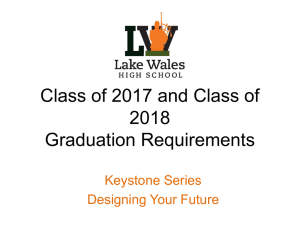Students with Disabilities Preparing for
advertisement
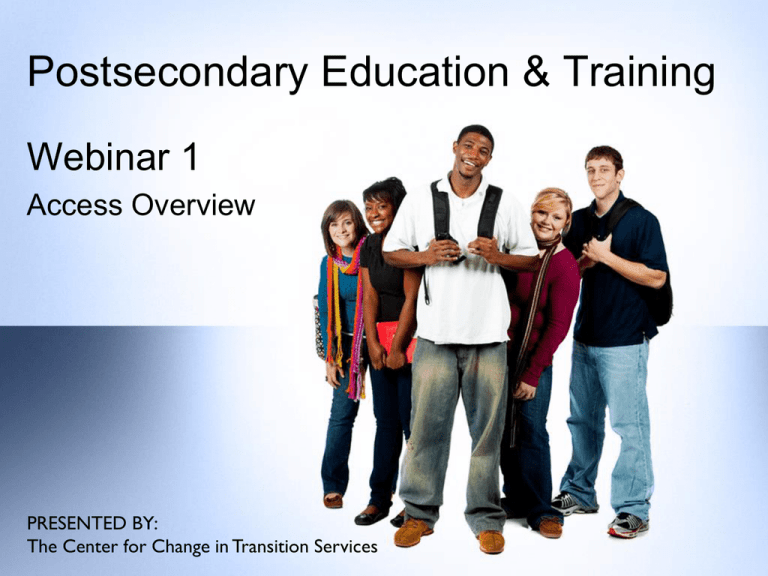
Postsecondary Education & Training Webinar 1 Access Overview PRESENTED BY: The Center for Change in Transition Services CCTS Webinar Series Welcome to the 2014-2015 Webinar series on postsecondary education and training. Presented by the Center for Change in Transition Services (CCTS), a Washington Special Education State Needs Project housed at Seattle University and funded through the Office of the Superintendent of Public Instruction (OSPI). CCTS has been serving special need students, their families and schools since 1990. CCTS Introductions Cinda Johnson Ed.D., Principal Investigator Sue Ann Bube Julia Schechter Ed.D., Director M.Ed., Doctoral Research Assistant 2014-2015 Webinars Access Overview October 8th Join us to learn how to utilize CCTS resources in your district to improve post-school outcomes and for an overview of major topics facing students with disabilities transitioning to postsecondary education. Strategies for Success November 12th Self-determination and self-advocacy are key attributes students should possess for success beyond graduation. Learn how these skills can be acquired in high school and applied in higher education environments. December 10th What are the education opportunities for students with disabilities post-high school? Options including on-line education, vocational education, and 2- & 4-year colleges and universities will be reviewed. Identifying Options Applying for Admissions January 14th Navigating admissions is challenging for everyone. This webinar will explore admissions issues specific to students with disabilities. February 11th Join us to explore how students with disabilities are impacted by the differences in law when transition between k-12 schools and higher education. March 11th Students with disabilities must seek their own accommodations after leaving high school. This webinar will explore what to expect and how this process works at different types of postsecondary institutions. April 8th Exploring financial aid resources and opportunities to finance postsecondary education will be the subject of this webinar. IDEA vs. ADA and 504 Accommodations Affordable? Transition Planning May 13th The focus of our final webinar will be preparing for a successful transition by learning how to write postsecondary education goals into the IEP and how to use the Summary of Performance (SOP) document as a passport to education. Registration 1) Everyone participating in the webinar needs to type the following in the chat box – Name – Email Address 2) You will be sent a link following the webinar to register for Clock Hours. You must complete the registration process to apply for clock hours! Thank you for joining us today! Closed Captioned (CC) This webinar is closedcaptioned. To view the captioning click on the CC icon just above the video. Webinar Norms Raise your hand and wait to be called on by moderator If you have a microphone, please keep it turned off until called on. You may ask questions by typing in the chat box or by raising your hand (if you have a microphone). Agenda 1. Overview of education/training transition data & issues 2. How to access & utilize CCTS data to improve outcomes 3. Postsecondary education/training resources 4. Question and answer Access Overview Data and Issues Postsecondary Education College or University (4-years, or more) Community College (2- years) Certificate, License (< 2-year) Vocational/technical training such as food service, automotive repair or a trade (e.g., plumbing, carpentry). Postsecondary Education Median Annual Income 2012 Bureau of Labor Statistics Postsecondary Education Average Unemployment Rate 2012 Bureau of Labor Statistics Postsecondary Education Students with disabilities . . . – are not prepared by senior year. (Hitchings et al., 2005) – do not enroll in higher education at the same rate as their non-disabled peers. (Wagner et al., 2005) – take 6 years to equal the college going rate of nondisabled peers (NLST2) – 25% of WA students with disabilities enroll in higher education within 1 year Postsecondary Education Critical Interrelationship Roadmap Beginning when the student turns 16, or before if appropriate (and updated annually), the IEP must include: Measurable postsecondary goals based upon age appropriate transition assessments related to training, education, employment, and where appropriate, independent living skills. The transition services (including courses of study) needed to assist the child in reaching those goals. U. S.C. §300.320(b) • Transition Services Flowchart Postsecondary Education Assess & Research Develop & Determine to develop realistic academic & career options a course of study and transition skills Plan ahead to insure accommodations will be in place after HS Teach Transition skills including self advocacy &selfdetermination skills Assess & Research . . . The ARC SD Scale Self-Determination – research-based – assess SD strengths and weaknesses – facilitate student involvement – develop SD goals and objectives Develop & Determine . . . Big Future: College Board Washington Career Bridge Transition Skills Transition Services Encourage students to: – take appropriate coursework. – use assessments to understand strengths, needs, interests, and preferences. – develop realistic academic and career options. – review disability- specific financial aid opportunities. – utilize accommodations during standardized testing (ACT, PSAT, SAT, etc.). – Understand college majors, admission requirements, entrance exams, and training opportunities. Transition Services Encourage students to: – start planning early. – develop a comprehensive transition portfolio. – access vocational rehabilitation services (DVR) – participate in ALL college related activities, such as college & career fairs and college tours. – be a self-advocate. From the GWU Heath Resource Center’s Guidance and Career Counselor’s Toolkit (2006) Plan . . . IDEA ADA Success Access Guarantee of services to those that qualify Prohibits discrimination Ages 3 - 21 All ages FAPE Equivalent access IEP No formal plan IEP Team Responsible Student/Employee Responsible Summary of Performance • Can be used as a passport to higher education. • Summarizes a student’s academic and functional performance and includes recommendations to help the student meet postsecondary goals. • Required as part of IDEA. Improving Outcomes Access and utilize CCTS data Access & Utilize Data Washington’s special education students who graduated or left high school between the ages of 16 to 21 are surveyed by school districts within 1 year of leaving high school. Data is reported to CCTS (funded by the Office of the State Superintendent) and then used to improve the transition services and post-school outcomes of students with disabilities. WA Post-School Outcomes Special Education 2011-2012 Key Findings FINDING #1 34.3% of students who exited high school with an IEP in are not engaged in any postsecondary activity. Key Finding Key Finding #2 51% of students who are enrolled in a school or training program a year after exiting high school are attending a community college. Key Finding Key Finding #3 The disabilities with the highest postsecondary education attendance: SLD (53%) Health Impairment (27%) Autism (6%) Your Findings? • How many students were interviewed/surveyed? • What types of postsecondary institutions are students attending, are they in geographic proximity? • Does the district have linkages in place to regional higher education institutions? • How many youth had postsecondary education as a goal and how many reached this goal? • Which youth reached this goal, was there a difference by disability, exit status, gender, ethnicity? • Where is there room for improvement? Resources Postsecondary education/training POSTSECONDARY EDUCATION RESOURCES Affordable Colleges Online: College Guide for Students with Disabilities http://www.affordablecollegesonline.org A complete guide to college financing for students with disabilities. Find expert advice on loans, grants and scholarships specifically for disabled students, as well as resources to help with the job search after graduation. Association on Higher Education and Disability (AHEAD) http://www.ahead.org/ AHEAD is a professional association committed to full participation of persons with disabilities in postsecondary education. Resources are provided for educators, parents and students. College Scholarships, Colleges, and Online Degrees http://www.college-scholarships.com The College Scholarships, Colleges and Online Degrees page offers college, career or graduate schoolbound, students of all ages easy access information about a wide variety of subjects which include: Free college scholarship and financial aid searches; SAT and ACT test preparation tips; information on colleges and universities throughout the U.S.; and information relating to online degree programs and distance education. Resources George Washington University HEATH Resource Center http://heath.gwu.edu/ The GWU HEATH Resource Center Clearinghouse provides information on transition to higher education including information about disability support services, policies, procedures, accommodations, and financial assistance. The Heath Guidance and Career Counselor Toolkit provides extensive resources. Online College Database - Directory of U.S. Colleges A complete guide to distance learning for students with disabilities. Learn how to work with disability services, employ assistive technology, evaluate online programs, and succeed in the virtual classroom. PEPNet, the Postsecondary Education Programs Network PEPNet, the Postsecondary Education Programs Network, is the national collaboration of the four Regional Postsecondary Education Centers for Individuals who are Deaf and hard of Hearing. The goal of PEPNet is to assist postsecondary institutions across the nation to attract and effectively serve individuals who are . Deaf and Hard of Hearing One publication is: Students with Disabilities Preparing for Postsecondary Education: Know Your Rights and Responsibilities. The College Board https://bigfuture.collegeboard.org/ The College Board’s Big Future page offers tools to help with planning for college, finding a campus and paying for college. Includes scholarship lists. Resources The College Navigator The National Center for Education Statistics (NCES) offers the college navigator tool, an easy-to-use feature designed to help students and parents learn about colleges and universities. The site has information on nearly 7,000 postsecondary institutions in the United States. http://nces.ed.gov/collegenavigator/ ThinkCollege! http://www.thinkcollege.net/index.php This website provides resources for students, families, and professionals supporting youth with intellectual disabilities exploring postsecondary education options University of Washington DO-IT (Disabilities, Opportunities, Internetworking and Technology) http://www.washington.edu/doit/ DO IT serves to increase the success of people with disabilities in challenging academic programs and careers. The website provides extensive college planning resources including a list of scholarships by disability. DO-IT produces: Preparing for College: An Online Tutorial: http://www.washington.edu/doit/Brochures/Academics/cprep.html United States Department of Education, Office of Civil Rights http://www2.ed.gov/about/offices/list/ocr/transition.html The USDE Office of Civil Rights has many resources and publications to support students, families and professionals explore options for transitioning to postsecondary education. One such publication is: Students with Disabilities Preparing for Postsecondary Education: Know Your Rights and Responsibilities. Questions & Answers Thank you for participating! CCTS Contact Information Email: ccts@seattleu.edu Phone: 206.296.6494 http://www.seattleu.edu/ccts References Individuals with Disabilities Education Act, PL. 94-142 as amended, 20 U.S.C. § 1400 et seq. (2007). College Board (2006). Education Pays: Second Update. Retrieved September 1, 2009. Retrieved from www.collegeboard.com/prod_downloads/press/cost06/education_pays_06.pdf Field, S., Martin, J., Miller, R., Ward, M., & Wehmeyer, M. (1999). A practical guide to teaching self-determination. Reston, VA: Council for Exceptional Children. HEATH Resource Center. (2006). Guidance and career counselor's toolkit. Advising high school students with disabilities on postsecondary options. Washington, DC: The George Washington University National Clearinghouse on Postsecondary Education for Individuals with Disabilities. Hitchings, W. E., Retish, P., & Horvath, M. (2005). Academic preparation of adolescents with disabilities for postsecondary education. Career Development for Exceptional Individuals, 28(1), 26-35. Lalor, A. R., & Madaus, J. W. (2013). Helping students with learning disabilities search for colleges: Tips for professionals. Insights on Learning Disabilities, 10(1), 53-72. Retrieved from http://search.ebscohost.com.proxy.seattleu.edu/login.aspx?direct=true&db=ehh&AN=89040695&site=ehost-live References Madaus, J. W., & Shaw, S. F. (2004). Section 504: The differences in the regulations regarding secondary and postsecondary education. Intervention in School and Clinic, 81-87. National Center for Education Statistics. (2000, June). Postsecondary students with disabilities: Enrollment, services, and persistence. Stats in Brief. Washington, DC: U.S. Department of Education. National Secondary Transition Technical Assistance Center. (2012). Indicator 13 Checklist: Form A & Form B. [Pdf]. Retrieved from www.nsttac.org/content/nsttac-i-13-checklist Shaw, S. F. (2009). Transition to postsecondary education. Focus on Exceptional Children, 42(2), 1-16. Shaw, S. F., Dukes III, L. L., & Madaus, J. W. (2012). Beyond compliance: using the summary of performance to enhance transition planning. Teaching Exceptional Children, 44, 6-12. Thomas, S. (2000). College Students and disability law. The Journal of Special Education, 30(4) 248-257. Newman, L., Wagner, M., Cameto, R., & Knokey, A.-M.(2009). The Post-High School Outcomes of Youth with Disabilities up to 4 Years After High School. A Report of Findings from the National Longitudinal Transition Study-2 (NLTS2) (NCSER 2009-3017). Menlo Park, CA: SRI International. References United States Department of Education, The Secretary of Education’s Commission on the Future of Higher Education. (2006). A test of leadership: Charting the future of U.S. higher education (ED-06—CO-0013). Retrieved from www2.ed.gov/about/bdscomm/list/hiedfuture/reports/final-report.pdf U. S. Department of Education, Office for Civil Rights. (2004). Students with disabilities preparing for postsecondary education: Know your rights and responsibilities. Retrieved March 1, 2005, Retrieved from www.ed.gov/about/offices/list/ocr/transition.html Wagner, M., Newman, L., Cameto. R., Levine, P., & Marder, C. (2007). Perceptions and expectations of youth with disabilities. A special topic report of findings from the National Longitudinal Transition Studey-2 (NLTS2) (NCSER 2007-3006). Menlo Park, CA: SRI International.
